Alabama is home to a wide variety of mushrooms, many of which can be found growing in the state’s diverse forests, grasslands, and fields.
There are more than 100 species of mushrooms that can be identified as native to Alabama. These mushrooms vary in color, shape, size and habitat preferences, making them an interesting part of the natural environment. Many fungi have unique culinary properties.
Mushrooms of Alabama include Morels, chanterelles, honeys, and oysters. And it’s worth noting, some fungi are more common than others. For example, honey mushrooms are plentiful in Alabama compared to morels.
Below is a comprehensive guide to help you identify mushrooms in the yellowhammer state.
List of Edible Alabama Mushrooms
You must practice caution when hunting mushrooms. Only harvest fungi that you can properly identify or better hunt in the company of an experienced forager
1. Wood Blewit
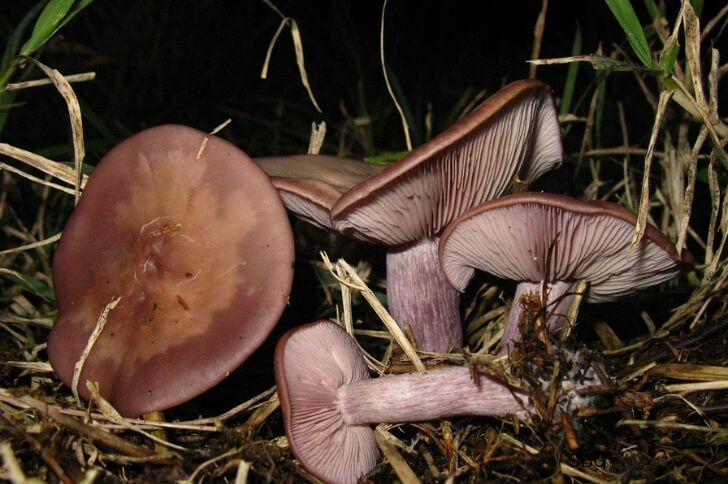
Identification:
Lepista nuda, commonly known as the wood blewit or clitocybe nuda, is an edible mushroom native to parts of the cotton state. Its cap ranges in color from pink to lilac, while its gills are purplish, turning brown as the fungi ages.
Stem grows to about 3 inches and may have a thick base. This species of fungus can be found growing in dense clusters in decaying litter. Another noteworthy feature of blewit is its distinct smell which has been described as similar to orange juice.
Uses
The wood blewit has a unique flavor described as sweet reminiscent of aniseed. These Alabama mushrooms are often used in recipes such as stews, pasta dishes and risottos – prepared correctly they make for a delicious addition to any meal!
2. Beefsteak Mushroom
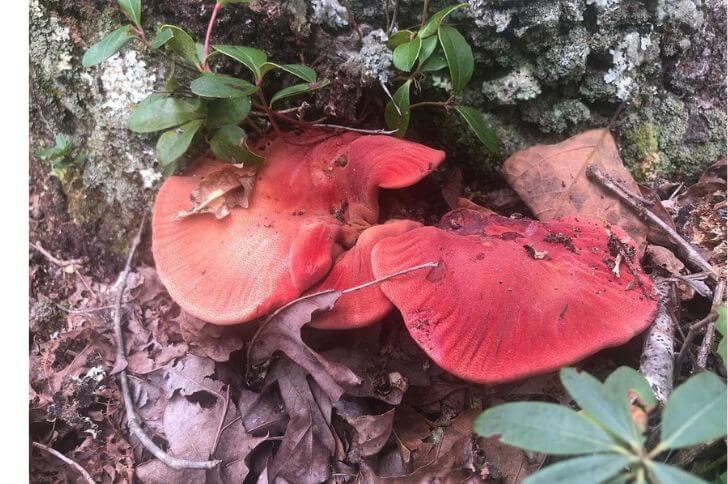
Identification:
Seen a tongue-like fungi sticking out of an oak tree? Beefsteak mushrooms are an attractive and edible type of mushroom that have a unique shape and coloration, many describing them as looking like a steak on a plate or a beef tongue.
This medium-sized mushroom has distinct features that help distinguish it from other types of fungi in Alabama.
Beefsteak mushrooms or poor man’s steak are usually between 4 to 8 inches wide with smooth red caps which become darker over time. The underside of the cap is covered in tiny pores. Cutting the mushroom, you’ll notice its red flesh that resembles beef and when pressed it produces a blood-like liquid.
Uses:
Its texture is meat-like, which makes it ideal for vegan dishes. What does beefsteak mushrooms taste like? They are sour. Let this not put you off from foraging for this mushroom. My thoughts and recommendations are, go for younger beefsteak mushrooms.
They are not as sour as older beefsteaks. They add a distinctive taste to my salads compared to most cultivated mushrooms.
3. Chicken of the Woods
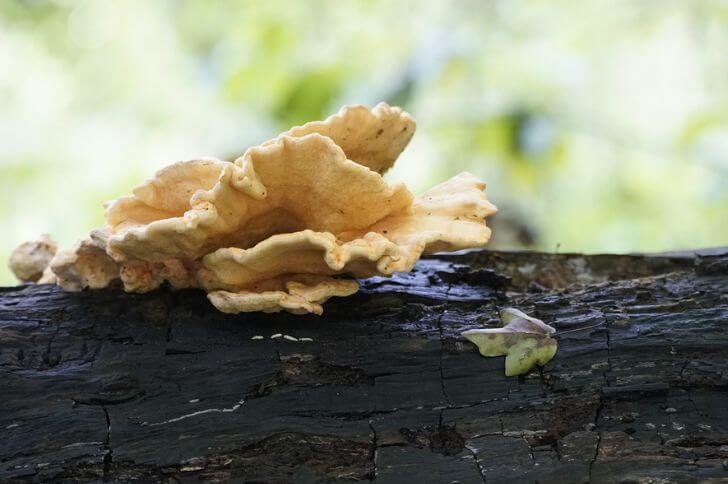
Identification:
Chicken of the woods mushroom is one of the most popular edible mushrooms of Alabama. This mushroom has a distinctive flavor and texture similar to chicken meat, making it an ideal vegan or vegetarian alternative when cooking.
This type of mushroom is characterized by its bright yellow-orange caps with soft frills along the edges. It grows in fan-shape clusters on trees like eucalyptus and sweet chestnut, although sometimes they can also be found growing on conifers. They are parasitic.
When foraging for Chicken of the woods mushrooms, it’s important to look for young specimens that are firm to the touch as more mature ones may be too tough to enjoy.
Uses:
How can you use chicken of the woods? You can deep fry or saute them. Best time to forage for them is from late summer to fall.
4. Hens of the Woods
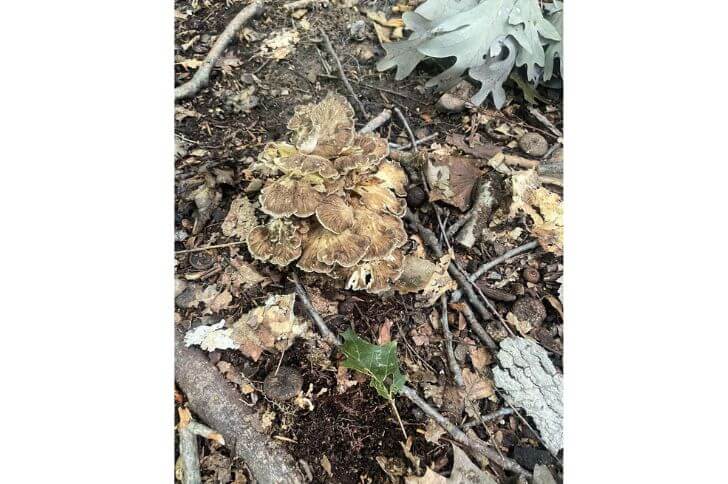
Identification:
Hens of the Woods mushrooms are another edible mushroom of Alabama. Don’t confuse it with the sulfur shelf above. They are from different fungi families.
To identify Hens of the Woods mushrooms, one should look for clusters growing around dead oak trees or stumps in autumn. It’s also important to note that they have unique spoon-shaped caps. Additionally, the caps will typically range from gray to brown. When cut into, the inside should appear cream-colored.
Uses:
Hens of the woods mushrooms or Grifola frondosa, are a favorite among mushroom hunters due to their flavorful taste. With an aroma of nuts, these mushrooms can be grilled or sauteed.
5. Deer Mushrooms
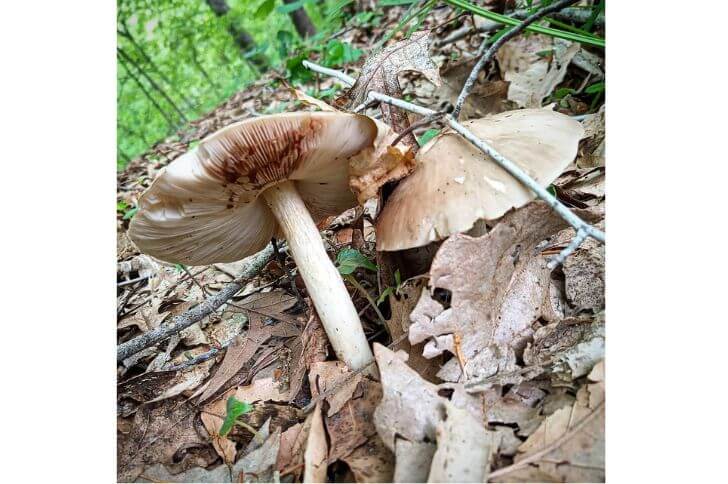
Identification:
Deer mushrooms are a much sought after delicacy in the wild mushroom of Alabama. Traditionally served fresh or dried as an accompaniment to meat dishes, these mushrooms can also be used to create savory sauces and soups.
These mushrooms get their unique name from the protrusions on their gills which resembles the antlers of a young buck.
They have a distinct appearance with brown caps that are convex in shape, gills on their undersides that are free or almost free, and thick stems with no volva. In addition, they have a distinctive smell that has been described as radish.
Uses:
Are deer mushrooms edible? Yes. Though not highly rated like morels, deer mushrooms are edible and are a great addition to sauces.
6. True Morels
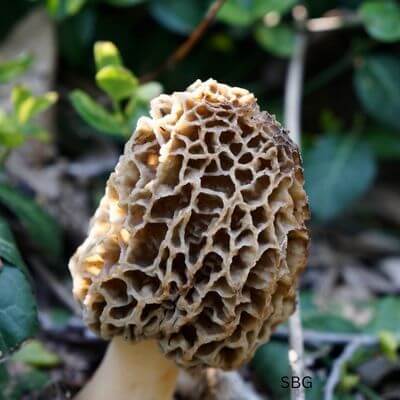
Identification:
Morels are a highly sought-after type of mushroom due to their unique flavor. Are there morels in Alabama? Yes, this pitted mushroom can be found in the Cotton State.
True morels have a distinct cap measuring about 2.4 inches when young. The cap ranges from gray to yellow-brown in color and has pits. Note the cap is longer than the whitish hollow stem.
Uses:
What do they taste like? True morels have a meaty flavor. You can use them to make soup or grill them.
If you’ve harvested more than you can consume in a single meal, select some that are dry, check that there aren’t any rotting parts. Place in a brown bag and refrigerate for up to one week.
Related Read: Common Southwest mushrooms
7. Lion’s Mane
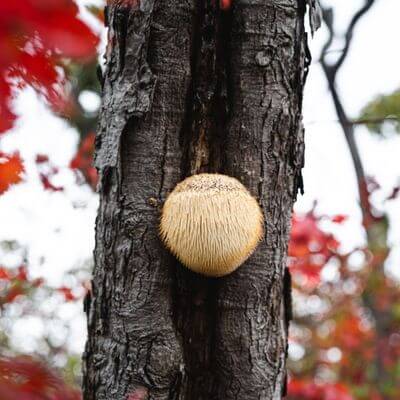
Identification:
Lion’s Mane are white mushrooms of Alabama that are also known as bearded tooth fungus. It is a unique species of tooth fungi characterized by its unique shape and appearance.
While these mushrooms look different from the average mushroom found in grocery stores, they can be identified with a few simple tips.
The most distinctive feature of Lion’s Mane mushrooms is their white color and unique spines that resemble the mane of a lion.
They also tend to be much larger than other varieties of mushrooms, with some specimens growing up to 15 inches wide! Other identifying features are they mostly occur on dying or dead hardwoods and appear in late summer to fall.
Uses:
These wild edible mushrooms in Alabama are very rare, so when you come across one, you are in for a treat. Here are some insanely good lion’s mane recipes
8. Yellowfoot Bolete
Identification:
Yellowfoot boletes are delicious red mushrooms of Alabama that are a member of the Boletaceae family, and are closely related to cep mushrooms.
The cap can reach up to 5 inches in diameter and has a distinctive reddish hue when young, becoming tan as it ages. Also it has a smooth surface which I find a little sticky.
The underside of the cap has pale pinkish pores that darken as the mushroom matures. This mushroom has a thick, reddish-yellow stem.
Uses:
The yellow-foot bolete is liked for its mild taste and firm texture when cooked. It’s also easier to clean compared to chanterelles.
It’s best enjoyed if harvested while young and quickly prepared by sautéing, grilling or baking them with other ingredients such as garlic and herbs.
9. Chanterelle
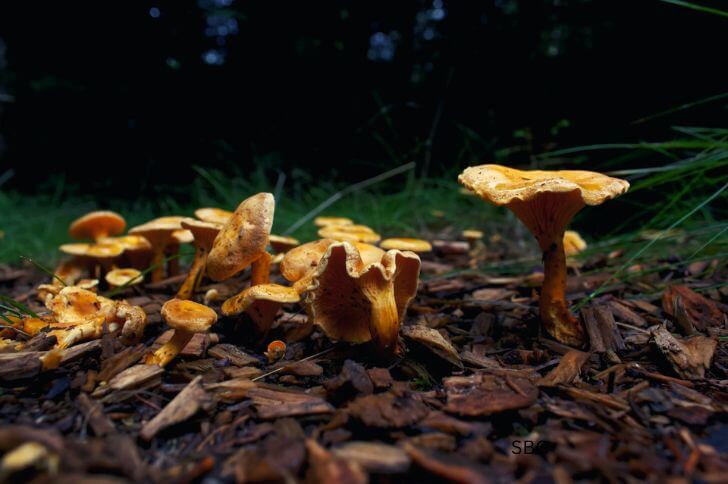
Identification:
Chanterelle mushrooms are prized for their beautiful, bright yellow color and earthy flavor. In Alabama you can find them on the ground growing in small clusters. Note if you find some growing on dead wood or stump, those are chanterelle look alikes and are not edible.
To distinguish these yellow Alabama mushrooms from other similar species, look underneath the cap. Chanterelles have deep ridges. They do not have gills. Also the false gills are forked.
Another way to differentiate them from other fungi is by checking their stem. Chanterelles have flesh in their stems. They are not hollow. And their flesh is stringy.
Uses:
Whether you’re using them to sauté or add umami flavors to soups or stews, chanterelles offer a wealth of culinary benefits due to their distinctive flavor. They’re low in calories.
When can you find chanterelles in Alabama? In the south they are found all-year round, in Central Alamaba chanterelles can be found from mid-may while fruiting bodies emerge later in spring in the northern part.
10. Cauliflower Mushrooms
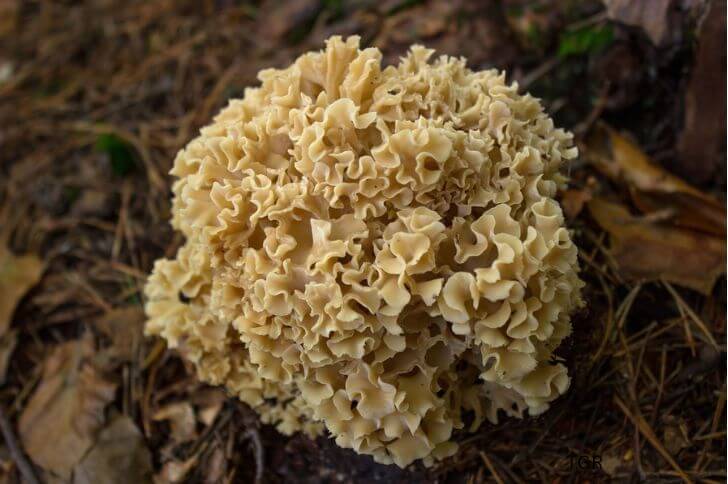
Identification:
Cauliflower mushrooms are very distinctive. These mushrooms are usually white, but can also range from light yellow to cream or brown shades. They get their name from their texture and appearance – they look like small cauliflower heads.
How should you harvest cauliflower mushrooms? You can find this Alabama mushroom around under pines or other hardwood trees. Do not pull it out. Instead, cut it at its base.
Uses:
How can you use common cauliflowers in Alabama? For older mushrooms, I recommend you trim the blackened tips. A mature sparassis can weigh up to 10 lb.
For a simple meal you can steam your cauliflower mushrooms or use for your risotto dishes. Due to their wavy caps and texture, these mushrooms are susceptible to insect infestation, so be sure to clean them properly.
11. Black Trumpet
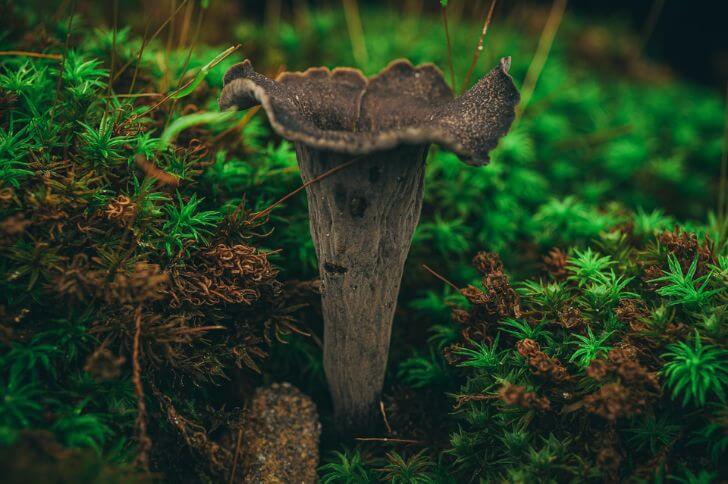
Identification:
Black trumpet mushrooms are a rare treat. And though not common, this edible black mushroom can be found in Alabama. How do you tell it apart from its look-alikes?
The easiest way to identify black trumpet mushrooms is by their distinctive coloration; they range from almost black to dark gray.
Their caps are funnel or trumpet-like, giving them their name. Like the chanterelle variety we discussed above, black trumpets also have false gills on their underside.
Also they grow on the ground individually or gregariously. You can find them from early July to late October. Check near small streams or mossy areas. You have to pay extra attention because of their color.
Uses:
Also called black chanterelle or horn of plenty, their unique sweet aroma, reminiscent of apricots, makes them an awesome addition to different dishes. You can use them to make sauces or candied mushrooms.
12. Indigo Milk Cap
Identification:
Are there edible blue mushrooms in Alabama? Indigo milk cap mushrooms, scientifically known as the Lactarius indigo, are an important blue fungus that occurs in Eastern North America.
These mushrooms can be identified by their bright blue gills and caps that span up to 6 inches in diameter.
They also have unique sunken convex caps that are sticky like the yellowfoot’s caps. Additionally, their thick stems can grow up to 3 inches tall and are mostly hollow. They bleed blue and their flesh bruises greenish when injured or cut.
Uses:
Milkcap mushrooms are plentiful from July through August. What do indigo milk caps taste like? They have a peppery taste and you’ll also note their grainy texture. When cooked they turn grey. I recommend stewing these blue Alabama mushrooms.
13. Hedgehog Mushrooms
Identification:
What do hedgehog mushrooms smell like? They have a sweet apricot scent. Apart from the telltale scent, you can identify these mushrooms by their smooth brown cap and spiny underside. The stem is whitish and thick. When bruised, their white flesh turns orange-brownish.
Uses:
Hedgehog mushrooms have a soft texture when cooked, but they must be cooked thoroughly.
The taste of hedgehog mushrooms is mild and nutty with a hint of sweetness. When properly cooked, they can be added to soups, stews, sauces, as well as stir-fries for an extra flavor boost.
14. Shaggy Mane
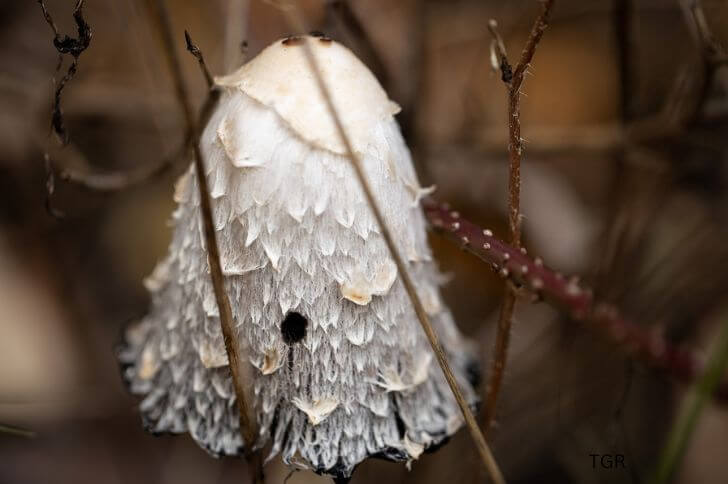
Shaggy mane are some of the most common yard mushrooms in Alabama. Also known as inky caps, these white edible mushrooms are fairly easy if you know what to look for.
The shaggy mane mushroom has a distinctive white stalk and cap that grows up to three inches long. The cap starts out bell-shaped and then almost flattens with age.
It is usually covered in soft scales that give it a shaggy or furry appearance, hence the name “shaggy mane”. As the mushroom ages its gills become black and release an ink-like substance when picked or touched. This is why they are sometimes called “inky caps”.
Uses:
Though not highly regarded, shaggy manes can be used to make mushroom soups. Ensure to pick young species before the caps turn black. It’s also worth noting they have a short shelf life, I recommend you cook them immediately after picking.
15. Reishi Mushrooms
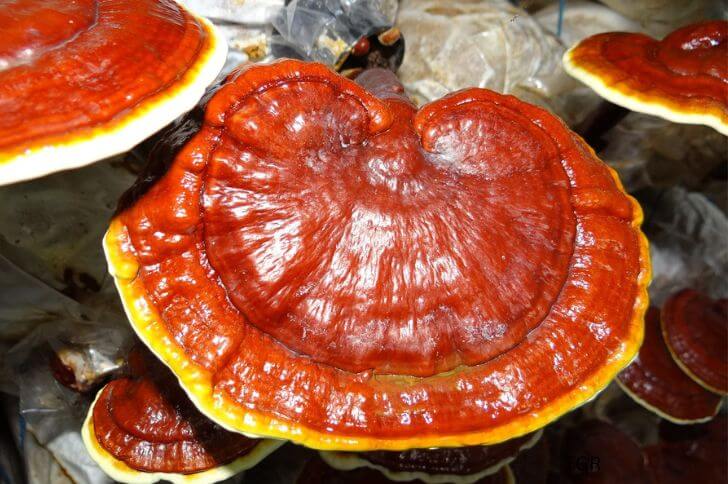
Identification:
Reishi mushrooms are found in the Alabama wild and also some local farmers grow them and supply them to local restaurants.
Also known as Lingzhi mushrooms, these mushrooms generally have a reddish-brown cap with white edges. Caps are semicircular, making identification easier.They have a brown spore print.
Reishi mushrooms are further distinguished by their unique scent, which has been described as ‘woodsy’. They tend to be more potent when fresh and may become fragrant upon drying.
Uses:
Reishi is a mushroom of many uses. From coffee to teas to veggie soups, you can come up with different ways to prepare it. This mushroom is also used in the creation of leather-like items.
16. Honey Mushrooms
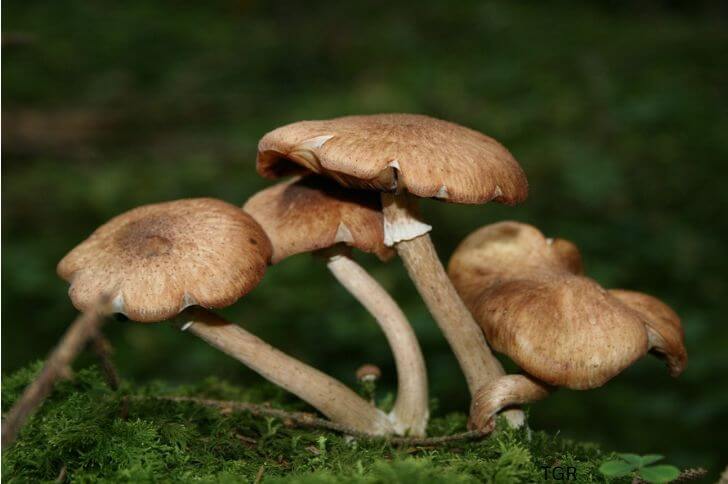
Identification:
Armillaria mellea informally known as Honeys, are a type of mushroom commonly found in Alabama. These mushrooms grow in clusters on dead roots of conifers and can be found in orchards too.
Honeys have yellow-brown caps which are convex for younger mushrooms and flatten with age. They have thick, white gills that are connected to the stem. The flesh of the mushroom is also whitish in color.
Uses:
Young caps are edible. I recommend you sautee them for a delicious treat. You can also use honeys to make a creamy soup.
17. Turkey Tails
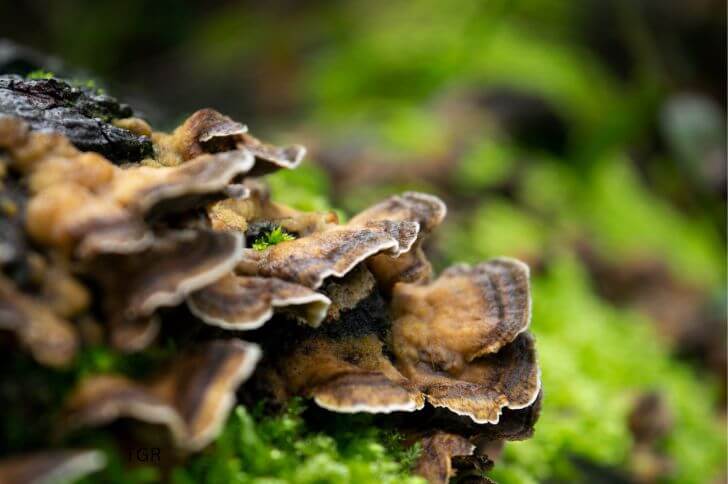
Identification:
Turkey tails mushrooms are a type of bracket fungus that have an unmistakable fan-like shape, making them easy to identify. They are brownish-gray in color and range from 1-4 inches across. It grows in overlapping clusters on dead or dying hardwoods.
Its underside features small pores instead of gills. Additionally, it has a leathery texture with concentric rings on top resembling the feathers of a wild turkey’s tail feathers.
Uses:
Can you eat turkey tail fungi? Yes, but with not distinctive taste and their tough flesh, I find them unpalatable. But, I find that drying them and using them in sauces or teas works.
18. Lobster Mushrooms
Identification:
Do lobster mushrooms grow in Alabama? Yes, you can spot them close to milk cap mushrooms starting from July. With some basic knowledge, it is possible to identify lobster mushrooms in nature.
The most distinctive feature of these mushrooms is their bright red-orange coloration. The cap surface is often wrinkled or folded – resembling the shell of a lobster. The underside usually has pores rather than gills. They typically grow up to 8 inches tall when mature, though they may appear smaller due to their curved caps.
Uses:
These orange-red mushrooms in Alabama are great for mushroom rolls, vegan tacos, pasta dishes, and more.
Inedible Alabama mushrooms include:
- Jack-o-lantern mushrooms
- False morels
- Destroying angel
Final thoughts on Mushrooms of Alabama
In conclusion,the mushrooms of Alabama are a wondrous and diverse group of fungi. They range from white to red to yellow mushrooms and each species has its own unique characteristics. If you are looking for some yummy treats, this Alabama mushroom guide will help you get started and identify edible wild mushrooms.
Hi There,
My name is Jenny. I’m the Chief Editor at Try Green Recipes and besides making yummy and healthy foods for my kids, grandkids, and friends. I’m new to the blogging world but I believe what I have to share is unique and will bring joy to your home. If you are adventurous and want try something tasty, let’s get started.

